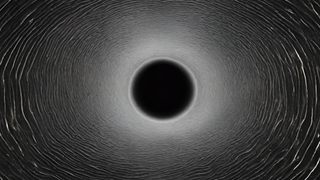
An illustration shows a black hole in a rippling superfluid
(Image credit: Robert Lea)
Thanks to immense gravitational forces, the regions around black holes are violent and turbulent environments driven by physics that cannot be found anywhere else in the universe. In fact, black holes are so influential that, when they rotate, they drag the very fabric of space along with them. In other words, near a black hole, nothing stands still. Nothing at all.
Clearly, black holes can’t be dragged down to Earth, so these effects can be studied in the lab — but a research team, led by University of Nottingham scientists, has done the next best thing. The researchers created, for the first time, a swirling “quantum vortex” in a helium superfluid chilled to ultracold temperatures. This apparatus essentially mimics a black hole right on our planet.
This is because the quantum tornado generated tiny waves on the surface of the superfluid, which is a material capable of displaying frictionless flow (or incredibly low viscosity) and other exotic behaviors observed at temperatures near absolute zero. These are behaviors that mimic conditions found near rotating black holes.
Related: 3D map of over 1 million black holes traces where the universe’s dark matter lies
“Using superfluid helium has allowed us to study tiny surface waves in greater detail and accuracy than with our previous experiments in water,” Patrik Svancara, team leader and a researcher at the University of Nottingham, said in a statement. “As the viscosity of superfluid helium is extremely small, we were able to meticulously investigate their interaction with the superfluid tornado and compare the findings with our own theoretical projections.”

(Left) the experimental set up used by the team (Right) the quantum tornado generated by the team in superfluid helium (Image credit: Leonardo Solidoro)
Swirling spacetime tornados
To understand how a superfluid vortex could resemble a black hole, it is vital to remember what Einstein’s 1915 theory of general relativity tells us about black holes. General relativity suggests that space and time are a single entity called spacetime, and that gravity arises when objects of mass cause spacetime to curve.
Black holes aren’t actually objects, but are regions of spacetime created by an infinitely dense and compact mass — a central singularity where the very laws of physics break down. The outer boundary of these spacetime regions is called the event horizon, and it represents the point at which not even light is fast enough to match the black hole’s escape velocity.
Breaking space news, the latest updates on rocket launches, skywatching events and more!
Black holes only have three known characteristics: Electric charge, mass and angular momentum, or “spin.” A rotating black hole, or a “Kerr black hole,” with angular momentum also drags the fabric of spacetime around with it in the direction of its rotation, an effect known as “frame dragging,” or the Lense-Thirring effect after the scientists who first proposed it.
Considering how the Lense-Thirring effect and forces matter around a Kerr black hole into constant motion, it makes sense that a vortex in a fluid, or maybe a tornado in the atmosphere, would be very loosely analogous to such a region of spacetime. But, what’s key with the team’s black-hole-simulation vortex is that it isn’t found in any old fluid. It was made in a superfluid chilled to absolute zero.

An illustration shows a rotating black hole dragging the very fabric of spacetime along with it. (Image credit: Robert Lea)
To conduct their experiment, the team constructed a bespoke cryogenic system capable of holding several liters of helium and chilling it to temperatures below minus 456 degrees Fahrenheit (minus 271 degrees Celsius). This is around 3 to 4 degrees above absolute zero, equal to minus 459.76 degrees Fahrenheit (minus 273.15 degrees Celsius). Absolute zero is theoretically the coldest possible temperature. At absolute zero, all atomic movement would cease.
At the temperatures achieved by the experiment, liquid helium develops quantum properties that would usually hinder the formation of giant vortices. This system showed how this can’t really be worked around; the team ultimately built a quantum tornado in the ultracold superfluid using a multitude of smaller parts.
“Superfluid helium contains tiny objects called quantum vortices, which tend to spread apart from each other,” Svancara continued. “In our set-up, we’ve managed to confine tens of thousands of these quanta in a compact object resembling a small tornado, achieving a vortex flow with record-breaking strength in the realm of quantum fluids.”
Svancara and colleagues found fascinating parallels between the quantum tornado and the way the gravity of black holes influences spacetime. The team hopes that the experiment will open up a way to simulate quantum physics more broadly within curved spacetime generally, and even around black-hole curved spacetime.
“When we first observed clear signatures of black hole physics in our initial analog experiment back in 2017, it was a breakthrough moment for understanding some of the bizarre phenomena that are often challenging, if not impossible, to study otherwise,” Silke Weinfurtner, leader of the Black Hole Laboratory where this experiment was developed and conducted, explained in the statement.
“Now,” Weinfurtner continued, “with our more sophisticated experiment, we have taken this research to the next level, which could eventually lead us to predict how quantum fields behave in curved spacetimes around astrophysical black holes.”
The team’s research was published on Wednesday (March 20) in the journal Nature.
Join our Space Forums to keep talking space on the latest missions, night sky and more! And if you have a news tip, correction or comment, let us know at: [email protected].
Robert Lea is a science journalist in the U.K. whose articles have been published in Physics World, New Scientist, Astronomy Magazine, All About Space, Newsweek and ZME Science. He also writes about science communication for Elsevier and the European Journal of Physics. Rob holds a bachelor of science degree in physics and astronomy from the U.K.’s Open University. Follow him on Twitter @sciencef1rst.
>>> Read full article>>>
Copyright for syndicated content belongs to the linked Source : Space.com – https://www.space.com/quantum-tornado-black-hole-physics-simulation-absolute-zero






























